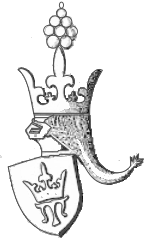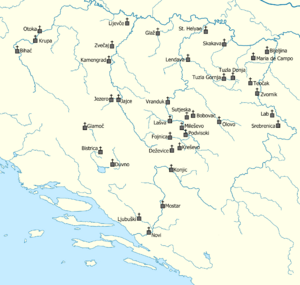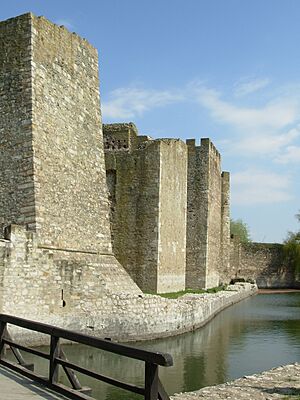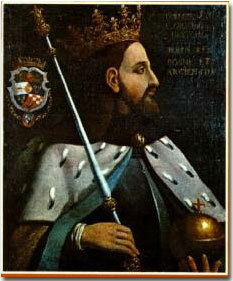Thomas of Bosnia facts for kids
Quick facts for kids Thomas |
|
|---|---|
| King of Bosnia | |
| Reign | November 1443 – July 1461 |
| Predecessor | Tvrtko II Tvrtković |
| Successor | Stephen II Tomašević |
| Born | c. 1411 |
| Died | 10 July 1461 (aged 49–50) |
| Burial | Bobovac |
| Spouse | Vojača Catherine of Bosnia |
| Issue more... |
Stephen II, King of Bosnia Ishak-bey Kraloglu Catherine |
| House | Kotromanić |
| Father | Ostoja, King of Bosnia |
| Religion | Roman Catholic previously Bosnian Christian |
Stephen Thomas (born around 1411 – died 10 July 1461) was a king of Bosnia. He was part of the House of Kotromanić. He ruled from 1443 until his death. He was the second to last king of Bosnia.
Thomas was the son of King Ostoja, born outside of marriage. He became king after King Tvrtko II died. But a powerful nobleman, Stjepan Vukčić Kosača, did not accept him as king. This led to a civil war. The war ended when King Thomas divorced his first wife, Vojača. He then married Catherine, who was the daughter of Stjepan Kosača.
Both Thomas and Catherine were raised in the Bosnian Church. They later became Roman Catholic. They helped build many churches and monasteries. During his rule, King Thomas fought with the Serbian Despotate. They fought over the rich mining town of Srebrenica. He also had many conflicts with his father-in-law.
Thomas also had a difficult relationship with the powerful Ottoman Empire. After many small fights, Thomas wanted to lead Christian armies against the Ottomans. But other Christian rulers did not help him. He tried to expand his kingdom into Croatia. When that failed, he looked east again in 1458. He arranged for his son Stephen to marry the Serbian princess Helena. Bosnia controlled parts of Serbia for only a month. Then the Ottomans conquered Serbia.
King Thomas's failure to protect Serbia hurt his image in Europe. To look better to Catholic rulers, he turned against the Bosnian Church. He became the first Bosnian ruler to persecute people for their religion. Thomas was seen as both admired and criticized by people at the time. His son Stephen became king after him. Stephen was better at handling the challenges of that time.
Contents
Early Life of King Thomas
Thomas was the son of King Ostoja. His mother's name is not known. He was born around 1411. Both his parents were married to other people at the time. Thomas grew up as a member of the Bosnian Church. His parents also followed this faith.
In 1421, Tvrtko II removed Stephen Ostojić from power. Stephen was Ostoja's only known legal son. Thomas's older brother, Radivoj, tried to take over from Tvrtko. He had help from the Ottoman Turks and the powerful Kosača family.
Thomas stayed out of the public eye during Tvrtko II's rule. He lived with a woman named Vojača and their children. He was loyal to King Tvrtko. They even fought together in Usora, where Thomas was hurt. Tvrtko had no children and was sick. He likely chose Thomas to be his successor. Thomas was a better choice than his brother Radivoj, whom Tvrtko disliked.
Becoming King
King Tvrtko II died in November 1443. The Bosnian council, called the Stanak, approved Thomas as the new king. He was officially elected king by December 5. Like kings before him, he added the royal name Stephen to his own.
However, the most powerful nobleman in Bosnia, Stjepan Vukčić Kosača, did not accept Thomas as king. Kosača supported Thomas's brother Radivoj instead. The nearby Republic of Ragusa was worried about this situation. Kosača and Radivoj asked Ragusa not to recognize Thomas. But Ragusa still recognized him.
At the same time, Ulrich II also claimed the Bosnian throne. He tried to get support from Thomas's enemies. Because of this, Thomas quickly sent news of his new role to other rulers. He contacted the German king Frederick IV and leaders in Ragusa and Venice. He hoped they would recognize him. Ulrich was busy with his own conflicts. This gave Thomas time to act.
War for the Throne
King Thomas quickly worked to make his position stronger. In January 1444, he moved into the region of Zachlumia. This area was controlled by the Kosačas. Kosača's nephew, Ivaniš Pavlović, joined Thomas. The Radivojević family, who were unhappy with Kosača, also joined them.
They soon took Drijeva. This important customs town returned to royal control. Kosača was also fighting Venice. He received no help from the Ottomans. So, he agreed to a truce in March. Both sides wanted time to get stronger. King Thomas tried to get Venice to promise help. He offered them control over some towns and mines for 25 years.
But in May, Thomas had successful talks with Hungary. This made the offer to Venice unnecessary. János Hunyadi helped Thomas get recognized by King Vladislav I of Hungary in June. In return, Thomas promised Hunyadi safe travel, shelter, and help. By summer, Thomas had a strong hold on the throne.
In July 1444, the Hungarian king told Thomas he would break the truce with the Ottomans. King Thomas decided to join the Christian alliance. In May, he had already taken Srebrenica, a rich silver mining town. The Ottomans had taken it from Serbia, and Serbia had taken it from Bosnia.
Thomas decided to fight Kosača again. Kosača was paying tribute to the Ottomans. The Turks then helped Kosača. They entered Bosnia, forcing Thomas to flee from Kozograd to Bobovac. This allowed Kosača to get back all he had lost. In August, the Ottomans gave Serbia back to Đurađ Branković. Branković then allied with Kosača against King Thomas.
In November 1444, the Hungarian army was defeated at the Battle of Varna. King Vladislav died there. This left Thomas vulnerable. He had to rely on Venice again. He repeated his earlier offer, but Venice refused. They made peace with Kosača. In April 1445, Thomas lost Srebrenica and the Drina Valley to Branković. Ivaniš Pavlović helped him again. They advanced towards Pomorje. Thomas retook Drijeva. But his advance stopped suddenly, maybe due to another Turkish attack or a truce. The fighting finally ended in September.
Changing Faith and Marriage
King Thomas had not been able to strengthen his power through force. So, he decided to find another way to bring peace to his kingdom. He likely planned to get closer to Kosača by marrying his daughter, Catherine. This idea probably came up in 1445. Thomas improved his relationship with the Holy See (the Pope). He wanted to be cleared of being born outside of marriage. He also wanted his marriage to Vojača to be cancelled.
Pope Eugene IV agreed on May 29. By then, Thomas seemed to have decided to join the Roman Catholic Church. Talks with Kosača became more serious in early 1446. King Thomas officially converted from Bosnian Christianity to Roman Catholicism. This was done by Tommaso Tommasini, a bishop. However, Cardinal Juan Carvajal only performed his baptism in 1457.
Thomas's plan to marry Kosača's daughter Catherine was announced in April. Their lands and borders went back to how they were before the war. Catherine, who was a Bosnian Christian, also had to convert to Catholicism for the marriage. These events angered Ivaniš Pavlović and Petar Vojsalić, another nobleman. But no conflict happened with them.
The royal wedding took place in mid-May in Milodraž. It was a big celebration with Catholic traditions. After that, the couple was crowned in Mile. For the first time, a crown was sent from Rome for a Bosnian king. A papal representative brought the crown from Spalato in July. But it never reached Thomas.
Becoming Catholic helped Thomas make alliances with Western rulers. It also brought Western culture to Bosnia. This included new styles in art, architecture, music, and fashion. Many Bosnian noblemen followed the King's example and converted to Catholicism. But some soon returned to the Bosnian Church. Kosača himself said he thought about converting but never did.
Many churches and Franciscan monasteries were built in Bosnia during Thomas's rule. Some were built by the King himself. Even though he tried to appear as a good Catholic king, Thomas's religious policy was not always strict at first. He continued to honor Bosnian Christians and their clergy. This caused arguments with local Franciscans. Pope Eugene agreed that Thomas had to tolerate other faiths for political reasons.
King Thomas's Reign
Peace brought stability to Bosnia and safety for Thomas. He took Srebrenica again in late 1446. He then made a temporary agreement with Branković. They would share the town and its mining profits. But this did not last. There were rumors that Hungarian noblemen thought about offering him the Hungarian crown. This showed his growing reputation.
The Ottomans wanted to weaken Bosnia by causing internal divisions. They were unhappy with the kingdom's stability. At the request of Đurađ Branković, the Turks attacked King Thomas's lands and his father-in-law's lands in March 1448. They looted and burned towns. Kosača, who now called himself "Herzog of Saint Sava", was forced to side with Branković against his son-in-law and king. In mid-September, Branković's brother-in-law, Thomas Kantakouzenos, led an army that included Kosača. They soundly defeated King Thomas.
King Thomas took Srebrenica again in February 1449. But fighting continued until 1451. Then the King made peace again with his father-in-law. The dispute was even brought before the Hungarian parliament. To pay for these constant wars and his royal court, King Thomas traded a lot. He made business deals with traders from Dalmatia. He relied heavily on his silver mines. But he made the most profit from his salt trade monopolies.
Family Conflicts
In 1451, Kosača wanted to improve his own economy. He started a war with the Republic of Ragusa. Thomas refused to join either side. But he still asked Pope Nicholas V to stop his father-in-law from being excommunicated. However, Ragusa continued. They promised to help Thomas take Drijeva from Kosača. They also promised to help him take Hodidjed from the Turks.
In the summer, Thomas was even approached by Kosača's family. This included the King's brother-in-law Vladislav and mother-in-law Jelena. They were very upset when Kosača took his son's bride as his concubine. In mid-December, Thomas finally agreed to a pact with Ragusa against his father-in-law. But the war ended quickly. Hungary and the Ottomans signed a truce. This truce specifically stopped the Ottomans' tributary from attacking Ragusa.
An open rebellion against Stjepan Kosača began in March 1452. Vladislav, with his mother and grandmother, raised an army. They took control of most of his father's territory. Thomas, Vladislav's king and brother-in-law, answered his call for help. He arrived with his army the next month. Ragusa also joined them.
However, King Thomas seemed unwilling to attack. He soon went back north to stop a Turkish attack. Kosača used this chance to get help from Venice. Venice took Drijeva from Vladislav. Kosača also encouraged uprisings against the rebels. Thomas returned, as he had promised. He chased the Venetians from Drijeva. He easily defeated his brother-in-law's enemies.
The alliance then suddenly broke apart. It became clear that Vladislav would not give up parts of his family lands that Thomas claimed. These included Drijeva and Blagaj. Blagaj was the Kosača family's main seat and key to Zachlumia.
A new conflict started in 1453. This was after the death of Petar Talovac. He had governed Croatia proper as a ban for the Hungarian king. Both Thomas and his father-in-law wanted to control Talovac's lands. They offered to marry his widow, Hedwig Garai. Kosača proposed himself, while Thomas suggested his son Stephen.
Kosača invited Turks to Bosnia in autumn. But neither side won. Venice moved in to protect Talovac's heirs. Thomas and Kosača then made peace. They realized that the Ottomans, who had just conquered Constantinople, would soon be at their own borders. Another concern was the end of the regency for the young Hungarian king Ladislaus the Posthumous. This reduced the influence of Thomas's friend János Hunyadi. It also led to the rise of Ulrich of Celje, who was supported by Kosača.
After Ladislaus made Ulrich the new Ban of Croatia, Ulrich started taking control of Croatian towns. This met strong opposition from Thomas. The Bosnian king feared that Ulrich would take Talovac's land. This would make Ulrich's territory border Kosača's. Not wanting to break peace with his father-in-law again, the King asked Venice for help.
Christian Alliance Efforts
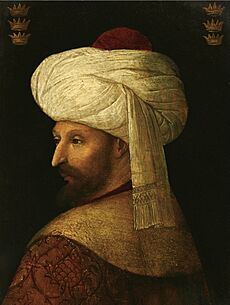
The Pope put King Thomas under his protection in 1455. He promised that Thomas would get back lands taken by Turks and his disloyal noblemen. This would happen if Christians defeated the Ottomans. In 1456, Thomas sent a letter to Pope Callixtus III. He asked the Pope to find a royal bride for his son Stephen. He hoped the Pope would provide a daughter-in-law of royal blood.
Preparations were underway for another Ottoman attack on Hungary in early 1456. Mehmed the Conqueror, the Ottoman sultan, made unusual demands to the King of Bosnia and his nobles. He asked Thomas to send 10,000 loads of food. He asked his father-in-law for 8,000 and Petar Pavlović for 4,000. Mehmed also demanded that they send their troops and personally join the war on the Ottoman side. He also asked Thomas to give up four towns. Two were in central Bosnia, and two bordered Hungary and Venetian Dalmatia. All these demands were refused.
By now, Thomas suspected that Mehmed also planned to conquer his kingdom. So, he started to show more interest in a Christian alliance against the Turks. He cooperated more closely with his father-in-law. The lack of stronger action against the Ottomans was blamed on Bosnian Christians. Thomas said they were more inclined towards Muslims than other Christians.
The heavy Ottoman defeat by Hungarians at the Battle of Belgrade in July 1456 did not help Thomas. Mehmed started putting even more pressure on Bosnia. Besides demanding money, Thomas was now forbidden to export silver. Mehmed claimed it for himself. This severely hurt the Bosnian economy.
The situation in Hungary worsened right after the victory over the Turks. The winning commanders, including János Hunyadi, died of plague. Ulrich of Celje was murdered. Even the young King Ladislaus died suddenly the next year. The old Đurađ Branković also died. His Serbian state passed to his son Lazar.
Thomas realized Hungary was much weaker. He also knew he had gone too far by refusing the Sultan's demands. So, Thomas decided to lead the Christian alliance. In August 1456, Ragusa received secret information from the King. He intended to declare war on the Turks. He was far from strong enough to succeed. He even suffered a Turkish raid in early 1457.
Pope Callixtus III took King Thomas seriously. He ordered that the King of Bosnia be given the Crusaders' cross, the papal flag, and crusading funds in July 1457. This marked him as the leader of the alliance. However, Thomas relied not on his own strength, but on help from Western rulers. His messengers to King Alfonso V of Aragon, the Doge of Venice, the Duke of Milan, and the Duke of Burgundy all reported refusals of help.
Cardinal Carvajal was sent to Bosnia to meet King Thomas. Another cardinal wrote that Carvajal would have been better off staying in Buda. Indeed, Carvajal found Thomas poorly prepared to fight the enemy. The Pope became disappointed with him. He transferred the leadership of the Christian alliance to the Albanian lord Skanderbeg.
Challenges and Decline
Efforts to Expand Territory
Even though the crusading efforts failed, Thomas still tried to expand his kingdom. The death of Ulrich of Celje, who had no heirs, opened the chance to seize Talovac lands. But his father-in-law acted faster. This led to another brief cooling in their relationship.
However, in January 1458, a new opportunity appeared on Bosnia's eastern border. The chaos after Lazar Branković's death allowed Thomas to retake the Bosnian part of the Drina River valley. Lazar's father had conquered this area in the previous decade. Thomas also expanded into the area on the right bank of the Drina.
Thomas captured a total of eleven towns. He kept Srebrenica, Zvornik, and Teočak for himself. He gave the rest to local noblemen who swore loyalty to him. He then turned his attention back to Croatia. He suggested to Venice that since the Hungarians had not yet appointed a new governor of Croatia, he and Venice should divide the area between them. In June, he warned Venice that the new Hungarian king Matthias Corvinus, Hunyadi's son, would not be a good neighbor to Bosnia or Venice if he took control of Croatia.
A large Turkish raid in February 1458 forced Thomas to sign a truce. This was despite his earlier promises to fight. But Mehmed no longer insisted on getting the four towns. He planned to conquer Serbia instead. At that time, King Thomas dropped the plan for his son to marry a duke's daughter. He felt this was not good enough for Stephen.
Instead, he successfully talked with Lazar's widow, the Byzantine princess Helena Palaiologina. They arranged a marriage between Stephen and her oldest daughter, Helena. This way, Thomas got a daughter-in-law of royal blood. He also found a way to extend his family's rule to Serbia. Serbia was then reduced to the Smederevo Fortress and its surroundings, as Lazar had no sons.
Thomas sent news of these plans to King Matthias, his feudal overlord, in October. In early December, Thomas himself went to meet Matthias at a meeting in Szeged. Matthias was very happy. He urged Thomas to send his son as soon as possible. During Thomas's long absence, Turks attacked Bosnia. They besieged Bobovac and Vranduk. But his son Stephen and brother Radivoj escaped. Thomas returned to Bosnia in mid-January 1459. He started fighting the attackers. He even tried to remove them from Hodidjed. In mid-April, he raided the areas around Hodidjed and besieged the fort.
Meanwhile, Thomas's son had married Lazar's daughter. He took control of Smederevo. Thomas boasted about his son becoming a ruler. But the arrangement was cut short. Mehmed arrived with a huge army outside Smederevo. Terrified, Thomas's son and brother agreed to surrender the town and fortress on June 20. They did this in exchange for safe passage.
Thomas and Radivoj were strongly criticized by the Hungarian king. Matthias told all of Europe that Thomas had sold the important fortress to the enemy. Thomas worked hard to clear his name. He explained to Pope Pius II that Smederevo could not have been defended. The King sent a group to the Council of Mantua in July. He promised to do his best to hold back the Turks and begged for help. The only ruler to help Thomas was Bianca Maria Visconti, Duchess of Milan. She sent 300 men.
Religious Persecution
Unlike other Balkan states at the time, religion did not usually control Bosnian politics. Its rulers and people were generally open to different religious beliefs. However, this changed in 1459 when the Ottoman threat grew. Pope Pius II told Thomas he would not help him as long as the Bosnian Church was tolerated. Thomas was eager to appear as a good Catholic. This was especially important after Hungarian accusations of betraying Christianity.
The decision Thomas made in 1459 made him the first Bosnian ruler to persecute people for their religious beliefs. Popes had long asked for this policy. The Bosnian Church had been weakened by Catholic and Orthodox efforts to convert people. Its own morale was low. Thomas ordered its clergy to either convert or leave his lands. Their large properties were taken, which probably helped him make this difficult decision.
The persecution lasted almost two years. About 12,000 people were forced to convert. Forty members of the clergy fled to his father-in-law's lands. In 1461, he sent three men accused of heresy to be questioned by Cardinal Juan de Torquemada in Rome. The Bosnian Church was almost completely destroyed by King Thomas.
The persecution did little to improve Thomas's reputation in Catholic Europe. In 1459, he had another argument with his father-in-law over Čačvina Castle. Kosača accused him of inviting the Turks who plundered his land. The accusation reached Pope Pius. The Pope ordered that the King be excommunicated if such a serious offense against Christian interests was proven. Although Thomas probably did invite the Turkish raiders, the excommunication never happened.
Final Years
The fall of Serbia meant that the eastern border of Thomas's kingdom was now the main defense against the Ottomans. However, Bosnia was not Mehmed's top priority. Thomas was forced to give up northeastern Bosnia in early 1460. This included Usora, Srebrenica, Zvornik, and Teočak. This allowed the Turks to cross the Sava River into Hungarian regions.
Both Thomas and his father-in-law knew that the Ottoman conquest of Bosnia was coming. They continued to seek foreign help. But they were also preparing for a life in exile. However, this did not help them settle their differences. They did not put up a more effective defense.
Thomas became ill in June 1461. He asked for a doctor from Ragusa. He died in July, at around 50 years old. He was buried in the royal tomb in Bobovac.
The exact details of his death are not clear. Rumors spread that his death was not natural. Some said his brother Radivoj and son Stephen had plotted against him. Later stories also involved Mehmed and Matthias in the plot. The Hungarian king was said to be the mastermind. Historians generally do not believe these rumors. Stephen became king after him. This helped the kingdom, as the disagreements between the king and his nobles were finally resolved.
King Thomas's Character and Legacy
Thomas was a man of many different traits. His good looks and noble behavior impressed people at the time. An Italian soldier he met in 1452 wrote that he had never met a prince so refined and dignified. He even said Thomas was better than a famous intellectual.
However, Thomas's changing mind and lack of courage also caused disrespect. He could be very generous but also very petty. His changing nature hurt his reputation abroad. His religious persecution and forced conversions caused disapproval at home. People cursed him in the early years of Ottoman rule in Bosnia. They blamed him for taking property from the Bosnian Church.
Thomas and Vojača had at least four children:
- Stephen, who became king after him.
- A son who died as a child during a trip.
- A daughter who married a Hungarian nobleman in 1451.
- Another daughter who married in 1451.
With Catherine, who lived longer than both him and his kingdom, Thomas had two children:
- A son named Sigismund, born in 1449.
- A daughter named Catherine, born in 1453.
|


